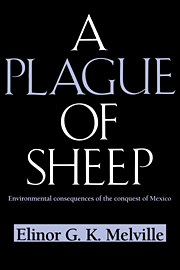Book contents
- Frontmatter
- Contents
- Illustrations and Tables
- Preface
- Chapter 1 Introduction
- Chapter 2 Alien Landscapes
- Chapter 3 The Australian Experience
- Chapter 4 The Mexican Case
- Chapter 5 The Conquest Process
- Chapter 6 The Colonial Regime
- Appendix A Sub-Areas
- Appendix B Population Estimates
- Appendix C Sources for Land Holding and Land Use
- Abbreviations
- Glossary
- Bibliography
- Index
Chapter 3 - The Australian Experience
Published online by Cambridge University Press: 05 August 2012
- Frontmatter
- Contents
- Illustrations and Tables
- Preface
- Chapter 1 Introduction
- Chapter 2 Alien Landscapes
- Chapter 3 The Australian Experience
- Chapter 4 The Mexican Case
- Chapter 5 The Conquest Process
- Chapter 6 The Colonial Regime
- Appendix A Sub-Areas
- Appendix B Population Estimates
- Appendix C Sources for Land Holding and Land Use
- Abbreviations
- Glossary
- Bibliography
- Index
Summary
What happens when pastoralism is introduced into a world that knows neither domesticated grazing animals nor the systems of resource exploitation peculiar to pastoralism? In Chapters 1 and 2 we discussed the consequences of the introduction of ungulates into new ecosystems; let us now look more closely at what happens when humans accompany these animals and manipulate the environment for profit.
There is a large and growing body of studies dealing with the relationship between pastoralism and environmental change, but they rarely tell us of the initial onslaught and, until recently, they did not allow for irreversible change. The majority of these studies, including those of the nineteenth-century American Southwest, are concerned with regions that were grazed in the past by Old World domesticates. The relationship between the grazing animals and the physical environment is that of a resident population and its subsistence base; the current population of grazing animals represents a phase in a cycle of resource exploitation. These studies use the ecosystem concept to order evidence of change according to an ideal of equilibrium: an ecosystem is seen as the consequence of interaction between climatic change (gradual, catastrophic, or cyclical), the physical structure of the landscape (rocks, soils, and vegetation), and the actions of the resident populations (human and faunal as well as floral). The possibilities for change are multiplied when the ecosystem is invaded by alien species.
- Type
- Chapter
- Information
- A Plague of SheepEnvironmental Consequences of the Conquest of Mexico, pp. 60 - 77Publisher: Cambridge University PressPrint publication year: 1994

